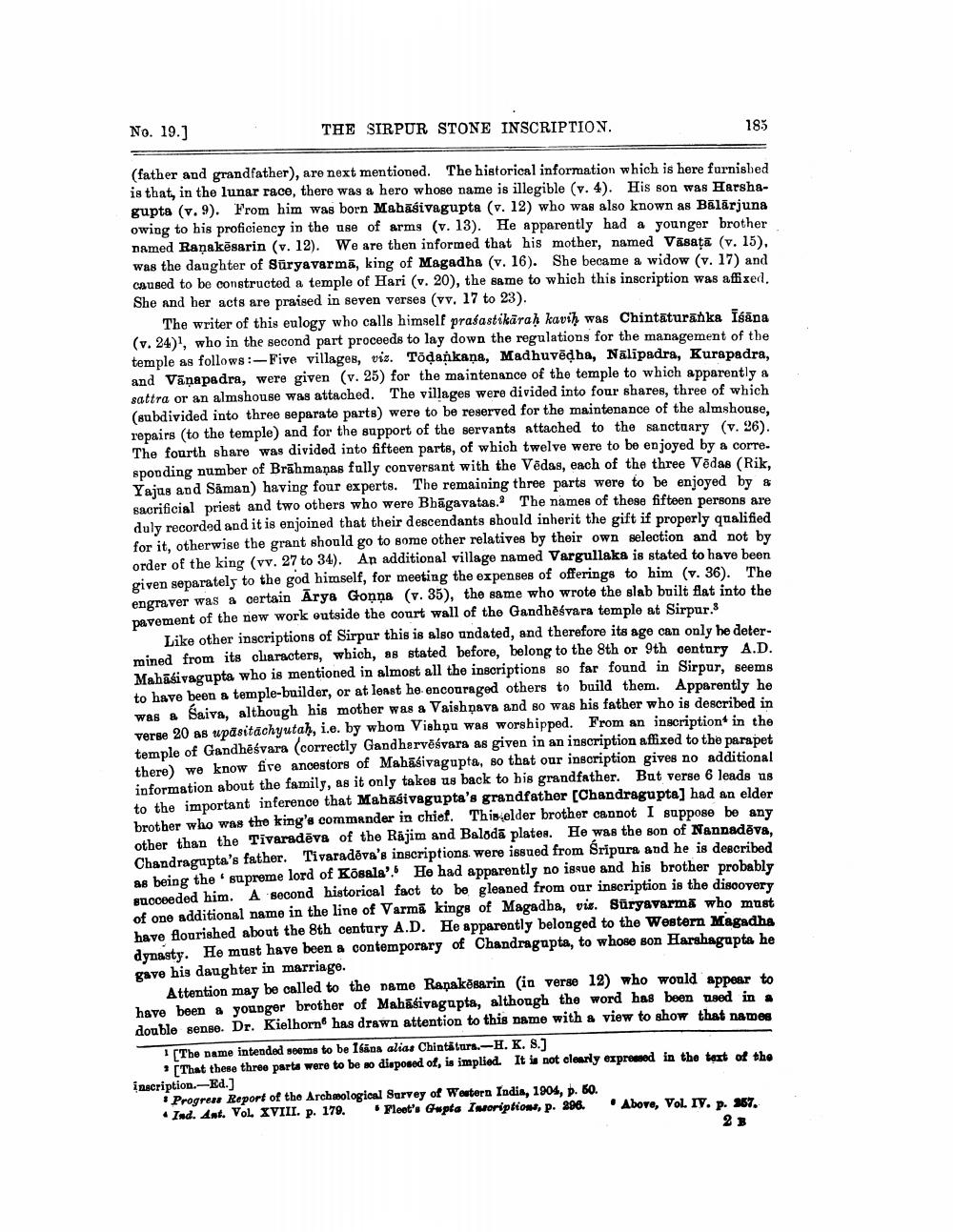________________
No. 19.)
THE SIRPUR STONE INSCRIPTION.
185
(father and grandfather), are next mentioned. The historical information which is here furnished is that, in the lunar race, there was a hero whose name is illegible (v.4). His son was Harshagupta (v.9). From him was born Mahāśivagupta (v. 12) who was also known as Bālārjuna owing to his proficiency in the use of arms (v. 13). He apparently had a younger brother named Raņakësarin (v. 12). We are then informed that his mother, named Vāsaţā (v. 15). was the daughter of Suryavarma, king of Magadha (v. 16). She became a widow (v. 17) and caused to be constructed a temple of Hari (v. 20), the same to which this inscription was affixed. She and her acts are praised in seven verses (vv. 17 to 23).
The writer of this eulogy who calls himself prasastikārah kavih was Chintaturanka Isana (v. 24), who in the second part proceeds to lay down the regulations for the management of the temple as follows:- Five villages, viz. Todaņkana, Madhuvēdha, Nālīpadra, Kurapadra, and Vāņapadra, were given (v. 25) for the maintenance of the temple to which apparently a sattra or an almshouse was attached. The villages were divided into four shares, three of which (subdivided into three separate parts) were to be reserved for the maintenance of the almshouse, repairs to the templeand for the support of the servants attached to the sanctuary (v. 26). The fourth share was divided into fifteen parts, of which twelve were to be enjoyed by a corre. sponding number of Brāhmaṇas fully conversant with the Vēdas, each of the three Vēdas (Rik, Yajus and Saman) having four experts. The remaining three parts were to be enjoyed by & sacrificial priest and two others who were Bbāgavatas. The names of these fifteen persons are duly recorded and it is enjoined that their descendants should inherit the gift if properly qualified for it, otherwise the grant should go to some other relatives by their own selection and not by order of the king (vv. 27 to 34). An additional village named Vargullaka is stated to have been given separately to the god himself, for meeting the expenses of offerings to him (v. 36). The engraver was a certain Arya Gonna (v. 35), the same who wrote the slab built flat into the pavement of the new work outside the court wall of the Gandhèsvara temple at Sirpur.
Like other inscriptions of Sirpur this is also andated, and therefore its age can only be determined from its characters, which, as stated before, belong to the 8th or 9th century A.D. Mahasivagupta who is mentioned in almost all the inscriptions so far found in Sirpur, seems to have been a temple-builder, or at least he encouraged others to build them. Apparently he was & Saiva, although his mother was a Vaishnava and so was his father who is described in verse 20 as upăsitachyutah, i.e. by whom Vishņu was worshipped. From an inscription in the temple of Gandhēśvara (correctly Gandhervēśvara as given in an inscription affixed to the parapet there) we know fire ancestors of Mabāsivagupta, so that our inscription gives no additional information about the family, as it only takes us back to his grandfather. But verse 6 leads as to the important inference that Mahāśivagupta's grandfather [Chandragupta] had an elder brother who was the king's commander in chief. This elder brother cannot I suppose be any other than the Tivaradēva of the Räjim and Balodā plates. He was the son of Nannadēva, Chandragupta's father. Tivaradėva's inscriptions were issued from Sripura and he is described as being the supreme lord of Kõsala'. He had apparently no issue and his brother probably encodeded him. A second historical fact to be gleaned from our inscription is the discovery of one additional name in the line of Varmā kings of Magadba, vis. Süryavarmā who must have flourished about the 8th century A.D. He apparently belonged to the Western Magadha dynasty. He must have been a contemporary of Chandragupta, to whose son Harghagupta he gave his daughter in marriage.
Attention may be called to the name Ranakosarin (in verse 12) who would appear to have been a younger brother of Mahāśivagupta, although the word has been used in a double sense. Dr. Kielhorn has drawn attention to this name with a view to show that names
[The name intended seems to be Ifans alias Chintäturs.-H. K. 8.)
[That these three parts were to be no disposed of, is implied. It is not clearly expressed in the text of the inscription. -Ed.)
• Program Report of the Archmological Survey of Western India, 1904, D. 50. Ind. Ant. VOL. XVIII. p. 179. Fleet'. Gupta Inforiptions, p. 296. Above, Vol. IV. p. 367.
2 B




